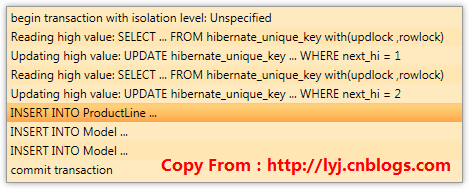NHibernate2.1新特性之EntityMode.Map
NHibernate2.1新特性之EntityMode.Map
本节内容
- 引入
- EntityMode
- 典型实例
- 1.映射文件
- 2.Configuration配置
- 3.测试
- 结语
引入
假设你想要持久化设计模型,而你不想写任何Domain实体。
假设你想在原有数据基础上测试ORM错误;而你不想写任何实体界面也没有任何实体实现。
假设朋友之间互相讨论问题,传你一些NH映射文件,来优化数据访问,但他并没有传你他的具体实现。
.........
总之,你就一堆NHibernate Mapping文件,你怎么办呢?按照映射结构试着重现Domain?还是直接放弃这些Mapping文件了?
不过我们有另外一个工具AjGenesis ,其IDE是AjGenesisStudio可以完成这项工作,但是学习成本的确高了点。
我可以告诉你,NHibernate可以做到,利用这些Mapping文件,对其测试,优化数据访问,如果你是世外高人甚至你的程序中没有Domain。
EntityMode
在NH2.1中EntityMode有三种,分别是:
- POCO
- Dynamic-Map (又称 Dictionary<PropertyName, PropertyValue>)
- Xml
EntityMode.POCO在常见不过了,就是NHibernate默认实体模式,NHibernate按照POCO来映射实体,操作实体。事实上,我们对EntityMode.Map并不陌生,在原来映射dynamic-component中已经使用了这个功能,就是一个属性名称为键,属性值为值的字典。在NHibernate2.1中,EntityMode.Xml还未实现,就是可以映射XML文件。
EntityMode.Map也就是所谓的动态实体。
典型实例
自己构建的例子有点不“官方”,我还是从NHibernate源码中摘取一个典型的实例说明一下吧。就是一个Mapping文件,然后对Mapping文件进行测试,看这个文件是否正确!或者可以优化下映射,例如级联、二级缓存什么的。
1.映射文件
在映射文件中,要声明entity-name来代替一个类名,对于entity-name也是NHibernate2.1的一个新特性,以后再写这方面文章介绍一下。
看到这个映射文件应该很熟悉,两个Domain,双向父子关系,就是一个生产线有N个模型案例了。
<class entity-name="ProductLine"> <id name="Id" type="int"> <generator class="hilo"/> </id> <property name="Description" not-null="true" length="200" type="string"/> <bag name="Models" cascade="all" inverse="true"> <key column="productId"/> <one-to-many class="Model"/> </bag> </class> <class entity-name="Model"> <id name="Id" type="int"> <generator class="hilo"/> </id> <property name="Name" not-null="true" length="25" type="string"/> <property name="Description" not-null="true" length="200" type="string"/> <many-to-one name="ProductLine" column="productId" not-null="true" class="ProductLine"/> </class>
2.Configuration配置
NHibernate默认设置是POCO模式。我们可以配置default_entity_mode选项设置一个默认的实体模式,这里我在这个Configuration中把default_entity_mode设置为EntityMode.Map。
[TestFixtureSetUp] public void TestFixtureSetUp() { cfg = new Configuration(); cfg.Configure(); //默认EntityMode为Poco,这里把default_entity_mode设置为EntityMode.Map cfg.SetProperty("default_entity_mode", EntityModeHelper.ToString(EntityMode.Map)); sf = (ISessionFactoryImplementor)cfg.BuildSessionFactory(); }
3.测试
使用Dynamic-Map,就是一个字典,这里先new出来一个Hashtable的ProductLine,再new出来两个基于Hashtable的Model字典,对ProductLine保存级联保存Model。其中ISession.Save()方法也是最新增加的一重载方法,然后对其查询,最后删除测试。
[Test] public void DynamicClasses() { //一个生产线有N个模型,这里模拟汽车生产线 IDictionary cars; IList models; using (ISession s = sf.OpenSession()) { using (ITransaction t = s.BeginTransaction()) { cars = new Hashtable(); cars["Description"] = "Cars生产线"; IDictionary ferrari = new Hashtable(); ferrari["ProductLine"] = cars; ferrari["Name"] = "Dino"; ferrari["Description"] = "法拉利Dino"; IDictionary lamborghini = new Hashtable(); lamborghini["ProductLine"] = cars; lamborghini["Name"] = "康塔克Countach"; lamborghini["Description"] = "蓝博基尼_康塔克Countach"; models = new List<IDictionary> { ferrari, lamborghini }; cars["Models"] = models; //第一个参数为映射中使用的实体名称,第二个参数为实例 s.Save("ProductLine", cars); t.Commit(); } } using (ISession s = sf.OpenSession()) { using (ITransaction t = s.BeginTransaction()) { cars = (IDictionary)s .CreateQuery("from ProductLine pl order by pl.Description") .UniqueResult(); models = (IList)cars["Models"]; Assert.That(models.Count == 2); s.Clear(); IList list = s.CreateQuery("from Model m").List(); var model = (IDictionary)list[0]; Assert.That(((IList)((IDictionary)model["ProductLine"])["Models"]).Contains(model)); s.Clear(); t.Commit(); } } using (ISession s = sf.OpenSession()) { using (ITransaction t = s.BeginTransaction()) { cars = (IDictionary)s .CreateQuery("from ProductLine pl order by pl.Description") .UniqueResult(); s.Delete(cars); t.Commit(); } } }
测试结果:
第一个Session:创建对象
第二个Session:查询对象
第三个Session:删除对象
结语
当然了,我们可以利用EntityMode.Map的动态实体,把一堆没有Domain的Mapping文件进行测试,优化等操作。
我还是通过通俗易懂的语言一篇一篇来介绍NHibernate里面的秘密吧。大家对EntityMode.Map有什么好的应用,一起交流下咯。
希望本文对你有所帮助!







 浙公网安备 33010602011771号
浙公网安备 33010602011771号